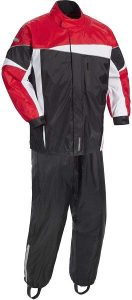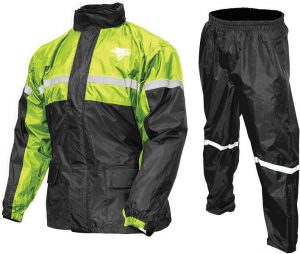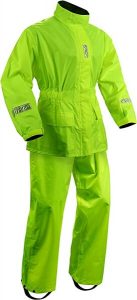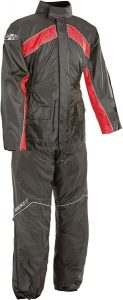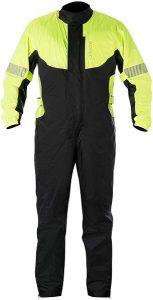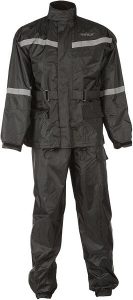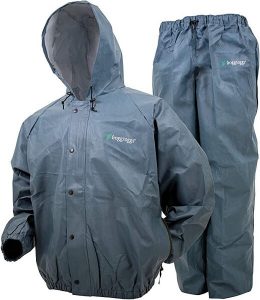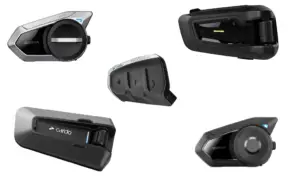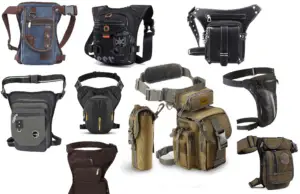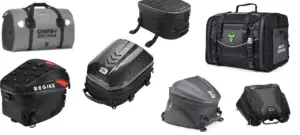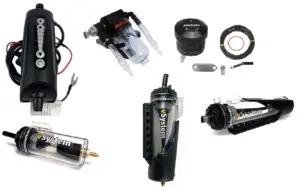Hate getting wet while riding your bike? Invest in quality rain gear. It keeps you dry and comfortable, no matter the weather. Need help choosing? Check out my top picks for the best rain gear.
I evaluated motorcycle rain gear products at a reasonable price based on durability, type, comfort features, ergonomic fit, breathability, and visibility. Here are my findings:
- #1 Joe Rocket RS-2 Rain Suit
- #2 Tourmaster Defender Rain Suit
- #3 Nelson Rigg Stormrider Rain Suit
- #4 Alpinestars Hurricane Rain Suit
- #5 Fly Racing Rain Suit
- #6 FROGG TOGGS
- #7 FWG Motorcycle Rain Suit
Contents
- Motorcycle Rain Suits
- #1 Tourmaster Defender Rain Suit
- #2 Nelson Rigg Stormrider Rain Suit
- #3 Joe Rocket RS-2 Rain Suit
- #4 Alpinestars Hurricane Rain Suit
- #5 Fly Racing Rain Suit
- #6 FROGG TOGGS
- #7 FWG Motorcycle Rain Suit
- What to Consider When Choosing a Rain Suit For a Motorcycle
- Importance of having proper rain gear while riding a motorcycle
- Factors to consider when buying motorcycle raingear
- Types of RainGear
- materials used in modern Motorcycle Rain Gear
- FAQ
Motorcycle Rain Suits
Best Overall
#1 Tourmaster Defender Rain Suit
- Material: polyurethane-backed nylon
- Type: 2-piece (jacket and pants)
- Neck Extension: ✅ Yes
- Breathable: ❌ No
- Visibility: ✅ Good
Other Features
✅ Has attached hood for under the helmet to stop drips down the neck.
✅ Has Loops that go under boots keeping pants extended all the way down and reducing the risk of water making its way up and into the boost
✅ Has a waterproof pocket in the chest area with a zipper.
Runner Up
#2 Nelson Rigg Stormrider Rain Suit
- Material: Soft polyester outer shell with PVC backing
- Type: 2-piece (jacket and pants)
- Neck Extension: ✅ Yes
- Breathable: ❌ No
- Visibility: ✅ Good
Other Features
✅ Self-Fastening Storm Flap ensures that rain cannot seep through the zipper, keeping the wearer dry and protected from the elements.
✅ Two large outer pockets offer convenient storage for phones, wallets, or keys and are easily accessible. When wearing rain gear, the standard gear pockets are inaccessible, making the pockets in the rain gear useful, especially during petrol station stops.
✅ Cooling Vents Under Each Arm promote air circulation, preventing the wearer from getting too hot and uncomfortable while wearing the rain gear. This feature ensures a comfortable fit and helps to regulate body temperature.
Also Good
#3 Joe Rocket RS-2 Rain Suit
- Material: Polyester outer shell with PVC backing
- Type: 2-piece (jacket and pants)
- Neck Extension: ✅ Yes
- Breathable: ❌ No
- Visibility: ⚠️ Low
Other Features
✅ Two large outer pockets
✅ Elastics on the waist for a better fit
Not Recommended
#4 Alpinestars Hurricane Rain Suit
- Material: poly-nylon fabric with tape-sealed seams
- Type: one-piece
- Neck Extension: ⚠️ small
- Breathable: ❌ No
- Visibility: ✅ Good
Other Features
✅ Velcro on the sides so that you could tighten the suit around your waist to keep it from flapping
⚠️ Elastic around wrists and ankles not tight enough
⚠️ No loops to go under boots. When sitting on a bike the cuffs are 2/3 of the way up and reveal ankles. You need long waterproof boots, otherwise, water pushed up by the front wheel will make its way over into your boots.
⚠️ Large size fits well, but tight in the crotch when arms are raised. If you have longer legs – this suit will be uncomfortable.
⚠️ Zipper goes partway down the left leg, which may leak
⚠️ No pockets in the suit, it would be nice to have an outside pocket for easy access.
Worth Mentioning
#5 Fly Racing Rain Suit
- Material: polyester shell
- Type: 2-piece (jacket and pants)
- Neck Extension: ✅ Yes
- Breathable: ✅ Yes
- Visibility: ⚠️ Medium
Other Features
✅ Slick inner liner makes putting the suit on a breeze
✅ Rear vents help allow humid air from inside suits to escape to keep you drier
✅ Two outer pockets, providing convenient storage for essentials such as phones, wallets, or keys, and can be easily accessed. While wearing Rain gear over standard gear, the standard gear pockets may not be easily accessible, making the pockets in the rain gear especially useful.
✅ Velcro tightening stips on the waist allowing you to tighten the suit around your waist to keep it from flapping
CHeapest Option
#6 FROGG TOGGS
- Material: Laminate polypropylene
- Type: 2-piece (jacket and pants)
- Neck Extension: ❌ No
- Breathable: ❌ No
- Visibility: ⚠️ Low
Other Features
⚠️ Not Motorcycle specific but a lot cheaper
⚠️ No Pockets
⚠️ Not fully Waterproof, water-resistant at best
⚠️ No elastic or velcro at the bottoms of the pants, the rain will make its way up the leg and into the boots
Best for Money
#7 FWG Motorcycle Rain Suit
- Material: Nylon, Polyurethane
- Type: 2-piece (jacket and pants)
- Neck Extension: ✅ Yes
- Breathable: ❌ No
- Visibility: ✅ Good
Other Features
✅ Has Loops that go under boots keeping pants extended all the way down and reducing the risk of water making its way up and into the boost
✅ Has outside pockets
✅ Has elastics on waste and sleeves for a tighter fit
✅ Is available in a green reflective color that greatly increases visibility and adds to passive safety when riding
What to Consider When Choosing a Rain Suit For a Motorcycle
Waterproof material: Look for a suit made of a waterproof and breathable material such as Gore-Tex or similar, to keep you dry and comfortable.
Fit: Make sure the suit fits well, allowing for movement and ventilation, without being too loose or restricting.
Visibility: High-visibility colors and reflective materials help improve your visibility on the road.
Convenience: Consider ease of use, with features like quick-release fasteners or pockets for storage.
Durability: Choose a suit that can withstand the wear and tear of riding, with reinforced areas in vulnerable spots.
Ventilation: Look for a breathable material that allows air through while being waterproof.
Importance of having proper rain gear while riding a motorcycle
Having proper rain gear while riding a motorcycle is crucial for ensuring safety and comfort. Rain gear helps to keep riders dry and protected from the elements, which can help to prevent hypothermia and other weather-related health issues. Moreover, rain gear may be used as an additional layer if the temperature drops, even if it is not raining.
In addition, wearing rain gear will make you more visible to other drivers since rain gear comes with light-reflecting strips. Furthermore, high-quality rain gear is often made of materials that are waterproof, windproof, and breathable, which can help to regulate body temperature and keep you comfortable, even in the harshest weather conditions. In short, investing in proper rain gear is an essential step for any motorcycle rider looking to stay safe, comfortable, and protected while on the road.
Factors to consider when buying motorcycle raingear
Firstly, it is important to consider the type of rain gear that you need, such as a full-body one-piece rain suit, two-Piece Rain Suit (rain jacket and rain pants), and waterproof boot covers.
Secondly, you should consider the material of the gear: such as Gore-Tex, polyurethane, or PVC, and the benefits and drawbacks of each material.
Thirdly, the size and fit is crucial, as you want to make sure that the gear is comfortable and flexible. Use a proper sizing chart to determine your size. Remember that you will be wearing a rain suit over your standard motorcycle gear, most known brands account for that in their sizing. So If, for example, you use an “L” size jacket – the L Size rain jacket should fit well.
Fourthly, it is important to consider features such as waterproofing, breathability, visibility, and storage options. Your gear should be easily accessible and quick to put on when stopping on the side of the road.
Finally, it is important to consider your budget and the cost of different types of rain gear, as well as the benefits of investing in high-quality gear. By taking these factors into account, you can find the best motorcycle rain gear for your needs and stay protected on the road.
Types of RainGear
Rain Suits – A rain suit is a complete set of waterproof clothing, including a jacket and pants, designed to keep the rider completely dry in wet weather. Rain suits are often made of durable and waterproof materials, and are designed to be worn over other clothing to protect the rider from rain and wind. Rains suits are divided into 2 main categories. The one-piece suits and 2-piece suits.
Rain Jackets – Rain jackets are a type of waterproof outerwear designed to protect the upper body from rain and wind. Rain jackets can be worn alone or as part of a complete rain suit, and come in a variety of styles and materials to meet the needs of different riders.
Rain Pants – Rain pants are a type of waterproof pants designed to protect the lower body from rain and wind. Rain pants can be worn alone or as part of a complete rain suit, and are often made of durable and waterproof materials.
Rain Boot Covers – Rain boot covers are designed to keep motorcycle boots dry and protected from rain and mud. They can be easily slipped over existing footwear. Wet roads can cause mud and water to be lifted by the front wheel and blown toward the legs below the knees. For instance, the Africa Twin is known for this type of occurrence, even when the road is slightly wet.
materials used in modern Motorcycle Rain Gear
Gore-Tex is a waterproof, breathable, and windproof material used in many types of motorcycle rain gear. It is a high-quality material that is known for its durability, comfort, and performance in wet weather conditions. It is made of a porous, microporous material that allows body heat and sweat to escape while preventing rain and wind from entering the gear. Put simply, the material has a structure that allows air to pass through its membrane, but its gaps are too small for water to penetrate.
Polyurethane is a type of synthetic material used in many types of motorcycle raingear. It is a lightweight, waterproof, and flexible material that is known for its durability and affordability. Polyurethane is often used as a more cost-effective alternative to Gore-Tex.
PVC or polyvinyl chloride is a type of plastic material used in some motorcycle rain gear. PVC is a waterproof and affordable material that is commonly used for budget-friendly rain gear. PVC is known for its durability and ease of care, but it can be less breathable than other materials, making it less comfortable for long rides in wet weather conditions.
Benefits and Drawbacks of Each Material
Each type of material used in motorcycle rain gear has its own unique benefits and drawbacks. Gore-Tex is a high-quality, durable, and breathable material, but it can be more expensive than other materials. Polyurethane is a lightweight, durable, and affordable material, but it may not be as breathable as other materials. PVC is a durable and affordable material, but it may be less breathable and less comfortable than other materials. When choosing rain gear, it is important to consider the specific benefits and drawbacks of each material and choose the one that best fits your needs and budget.
FAQ
Q: What’s better: a rain suit or a waterproof jacket?
A rain suit is a better option for extended periods of riding in heavy rain as it provides full coverage and keeps the rider dry from head to toe. However, it can be bulky and uncomfortable to wear for long periods of time, and it can also be more challenging to put on and take off while wearing motorcycle gear.
A waterproof jacket is a good option for short periods of rain or for riders who prefer a lighter, more breathable option. It is easier to put on and take off and provides protection to the upper body, but it does not provide full coverage and may leave the rider’s lower body exposed to the elements.
In conclusion, the better option between the two is determined by personal preference, the type of riding, and the weather conditions. Note that the rain suit doubles as an additional layer during cold riding and adds a lot of comfort during cold weather riding.
Q: How do I select the correct size of a motorcycle rain suit?
When purchasing a motorcycle rain suit, it is important to keep in mind that most manufacturers are aware that their suits will be worn over standard motorcycle gear. As a result, it is recommended to buy the same size rain suit as your motorcycle gear. For example, if you wear an M-size jacket, choose an M-size rain suit. This will ensure that the rain suit fits properly and does not impede your mobility while riding.
When selecting the correct size of a motorcycle rain suit, you should consider the following:
- Measurement: Take your body measurements, including height, weight, chest, waist, and inseam, to ensure the suit will fit correctly. It is recommended to check the manufacturer’s size chart for the specific product you are interested in.
- Fit: Rain suits should fit snugly but not too tight, allowing for freedom of movement. You want to ensure that the rain suit will not impede your mobility while riding.
- Layers: Keep in mind the type of clothing you will be wearing underneath the rain suit, such as additional layers or bulky motorcycle gear. You may need to size up to accommodate for additional clothing.
- Comfort: Consider the type of motorcycle you will be riding, as well as your personal preferences, such as the amount of ventilation you need. Make sure the rain suit allows for comfort and mobility while riding.
- Try it on: If possible, try on the rain suit before purchasing. This will give you a better idea of the fit, comfort, and mobility of the suit.
It is recommended to consult the manufacturer’s size chart and take your body measurements to determine the correct size for you. Additionally, trying on a rain suit before purchasing can help you make a more informed decision.
Q: How do I clean my motorcycle rain gear?
Check the label of the rain gear for any specific cleaning instructions provided by the manufacturer. Some rain gear may require special care, such as hand-washing or air-drying.
Q: How do you pack rain gear on a motorcycle?
Rain gear should be quickly accessible. Pack it in a location that is easily accessible. You should be able to quickly put it on if it starts to rain, and it’s ideal to be able to stop on the side of the road and put rain gear on in just three minutes if you see dark clouds on the horizon. I keep my rain gear in a tail bag attached to the back seat, while my friend prefers to keep his in his tank bag.
